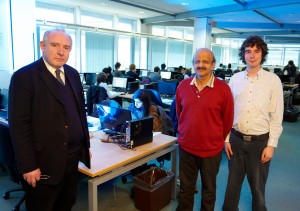
Researchers from the University in collaboration with engineers from RWE npower are calling a truce to a century-old ‘War of the Currents’ having proven the value of direct current (DC) power in a world of widespread computer use, low energy LED lighting and renewable energy technologies.
The unique research project, named ‘Edison SmartDC’, saw the installation of Britain’s first local DC micro-grid in the University’s library. The network was commissioned over Christmas 2010 and has now been running for its first year.
Researchers from the University and RWE npower’s engineers undertook an in-depth study of energy consumption together with other aspects of the Smart DC network over a period of 12 months. They are now able to demonstrate that running devices on DC rather than alternating current (AC) has the potential to be both more secure and more energy efficient.
The system was installed in the University’s library with a centralised AC/DC converter which converts the AC power from the National Grid into DC power which is then used to run a suite of 50 specially adapted computers and monitors.
The project has been funded by RWE npower and the University’s EPSRC Knowledge Transfer Account, with Western Power Distribution joining the project during 2011.
The team also installed a sophisticated system which monitored the network continually throughout the study, logging AC and DC voltages and currents, real and reactive power, power factor and harmonics together with computer usage.
Dr Miles Redfern of the Department of Electronic & Electrical Engineering, said: “The advantages we have demonstrated with this system are to the computer users, to those who pay the energy bill and to the environment.”
One of the key advantages of the new network is the potential for reduced energy consumption. The research team has taken into account reductions achieved by the replacement of old machines with newer, more efficient models as well as the move from AC powered machines to those powered by DC.
The use of DC power has resulted in increased energy efficiency in the computers with reduced heat output and therefore fewer, quieter cooling fans in the computers and a reduction in the use of air conditioning for the workspace.
Professor Raj Aggarwal, the project lead, said: “The system is also significantly more secure than an AC network, both because DC power supply units are simpler and because of the battery storage built into the system.
“By using battery storage, a back-up power source is available if the mains supply fails for any reason. While this is useful in a University, in some situations it could be essential. This level of energy security would be really important for someone relying on medical equipment, security systems or even lighting. It is much simpler than using a generator.”
Smart management of the network, including the battery storage, allows CO2 savings to be made. Unlike the production of energy from fossil fuels, renewable energy production can only be accessed when the resource – such as the wind blowing or the sun shining – is there. The batteries and DC network allow this energy to be stored for use later when required.
The system also allows energy to be stored from the National Grid in its batteries during times of low ‘carbon-intensity’ (typically overnight). It can then be used later when the National Grid has a higher carbon-intensity, with resulting CO2 savings. The same system also enables advantage to be taken of low ‘off-peak’ tariffs.
Professor Aggarwal said: “We have demonstrated that a carbon saving of 18 per cent is possible by switching to DC power and operating from the battery storage system using smart management.
“Obviously in addition to providing a more environmentally friendly option, this also allows power to be stored at off-peak prices and ultimately cuts costs for the bill payer.”
In addition to these benefits, the Smart DC network also reduces harmonic distortion. Benjamin Williamson, Knowledge Transfer Fellow for the project, said: “Harmonics are undesirable distortions that are transmitted into the grid. Essentially, they represent loss and can damage local electricity distribution equipment. Consumers who are heavy ‘harmonic polluters’ are penalised.
“Large concentrations of computers typically cause high harmonic distortion. We have demonstrated that by using one central AC/DC converter, harmonics are significantly reduced, some by a factor of 2-4 times, resulting in further savings for the consumer.”
As the experience of its computer users is essential to the University, the research team established a collaboration with the University’s Department of Psychology to test the impact on those using the network. The results can be attributed to both the new equipment and to the DC power.
Dr Ian Walker, Department of Psychology, said: “Users experienced a fast, quiet and compact computer with a clear, bright monitor. Due to running on DC power, there is a reduced heat output, which is shifted away from the user to the central AC/DC converter, reducing fan noise and the need for air conditioning. As a result the working environment for the user is improved by the DC system.”
Jacob Allinson, Electrical Engineer and project engineer at RWE npower said: “Systems such as what we have developed with the University of Bath are an exciting glimpse in to what a truly ‘Smart’ building could be. Without changing one’s day to day working practices, systems like Edison SmartDC allow users to optimise their consumption whilst at the same time reducing their bills, their carbon footprint, increasing energy security and allowing potential revenue streams from renewable energy integration. This is truly fascinating stuff.”
As a result of this successful research project the University of Bath , with RWE npower, Western Power Distribution and Siemens, have been awarded funding for Project BRISTOL under OFGEM’s Low Carbon Network Fund to apply the knowledge gained to similar schemes in the local community.



